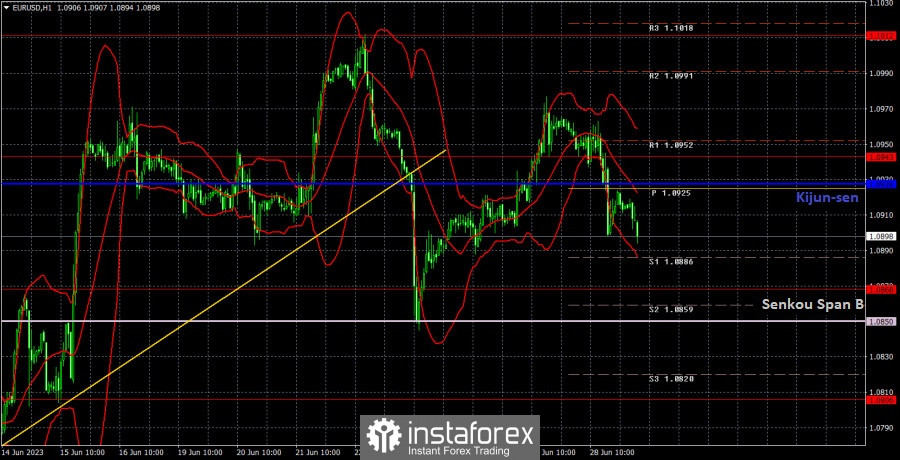

The EUR/USD pair traded lower on Wednesday. As we have mentioned before, we believe that the euro, along with the pound, should move downward, as they have risen significantly over the past 10 months and a substantial bearish correction is necessary in the long term. However, a sharp decline has not started yet because the European Central Bank and the Bank of England constantly reinforce their hawkish stance on interest rates, which leads to either the absence of a decline or even some growth for the euro and pound. However, yesterday, Federal Reserve Chairman Jerome Powell said that most members of the Federal Open Market Committee expect two more key rate hikes, which is slightly more than what the market anticipated. Therefore, the US dollar also receives some support from this news from time to time.
Volatility remains moderate despite a strong fundamental background. Although the pair is moving, the distances it covers in a day does not bring significant profit. Yesterday, there were two entry points. Initially, the pair bounced off the 1.0943 level but only managed to rise by 10 pips. The long position should have been manually closed before the start of the US session, as ECB President Christine Lagarde and Powell were set to deliver speeches. Afterwards, traders received a sell signal as the pair breached the critical line, and the pair fell by about 20 pips. This trade should also have been manually closed as there were no other signals until the evening. Therefore, the day ended with a small profit.
COT report:
On Friday, a new COT report for June 20 was released. In the last 10 months, COT reports have fully corresponded to what is happening on the market. The chart above clearly shows that the net position of big traders (the second indicator) began to grow again in September 2022. At the same time, the euro resumed an upward movement. The net position of non-commercial traders is bullish. The euro is trading at its highs against the US dollar. I have already mentioned that a fairly high value of the "net position" indicates the end of the uptrend. The first indicator also signals such a possibility as the red and green lines are very far from each other. It often occurs before the end of the trend. The euro tried to start falling a few months ago but there was only a pullback.
During the last reporting week, the number of long positions of the "non-commercial" group of traders increased by 3,200 and the number of short positions rose by 10,400. Accordingly, the net position fell by 7,200 contracts. At the moment, even without the COT reports, it is clear that the pair should continue to decline.
1H chart of EUR/USD
In the 1-hour chart, the pair consolidated below the ascending trendline but failed to overcome the important Senkou Span B line. The euro is currently trading lower, so we expect it to fall towards Senkou Span B in the near future. Now is a good time for a new phase of the downtrend in the medium term, but still within the range of 1.05-1.11.
On June 29, trading levels are seen at 1.0658-1.0669, 1.0762, 1.0806, 1.0868, 1.0943, 1.1012, 1.1092, 1.1137, as well as the Senkou Span B line (1.0850) and the Kijun-sen line (1.0928). Ichimoku indicator lines can move intraday, which should be taken into account when determining trading signals. There are also support and resistance although no signals are made near these levels. Signals could be made when the price either breaks or bounces from these extreme levels. Do not forget to place Stop Loss at the breakeven point when the price goes by 15 pips in the right direction. In case of a false breakout, it could save you from possible losses.
Today, Germany will release a new inflation report for June, Powell will give a speech, and the US will release reports on jobless claims and GDP for the first quarter in the final assessment. As we can see, there will be enough important events today to expect significant movement.
Indicators on charts:Resistance/support - thick red lines, near which the trend may stop. They do not make trading signals.
Kijun-sen and Senkou Span B are the Ichimoku indicator lines moved to the hourly timeframe from the 4-hour timeframe. They are also strong lines.
Extreme levels are thin red lines, from which the price used to bounce earlier. They can produce trading signals.
Yellow lines are trend lines, trend channels, and other technical patterns.
Indicator 1 on the COT chart is the size of the net position of each trader category.
Indicator 2 on the COT chart is the size of the net position for the Non-commercial group of traders.